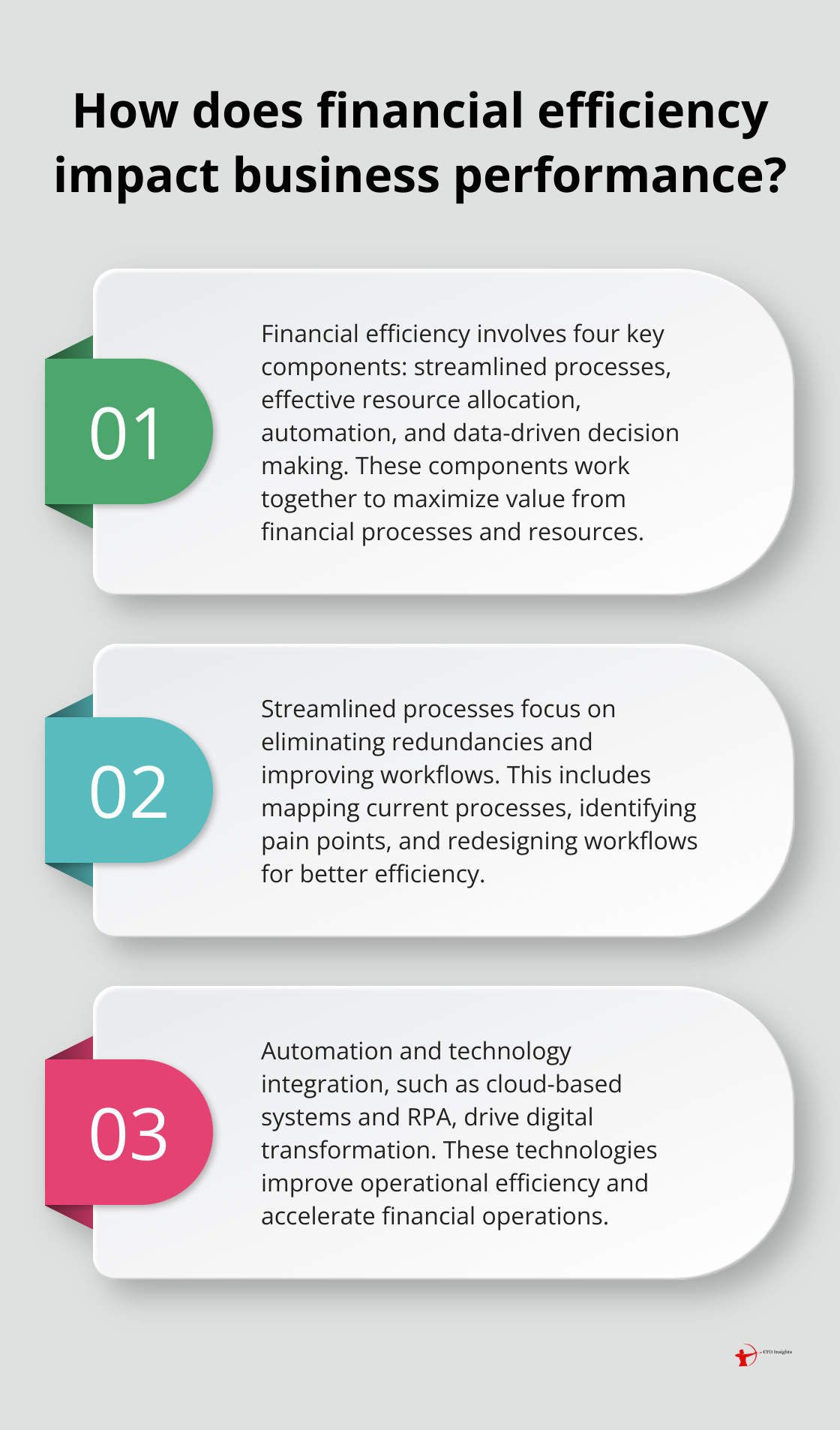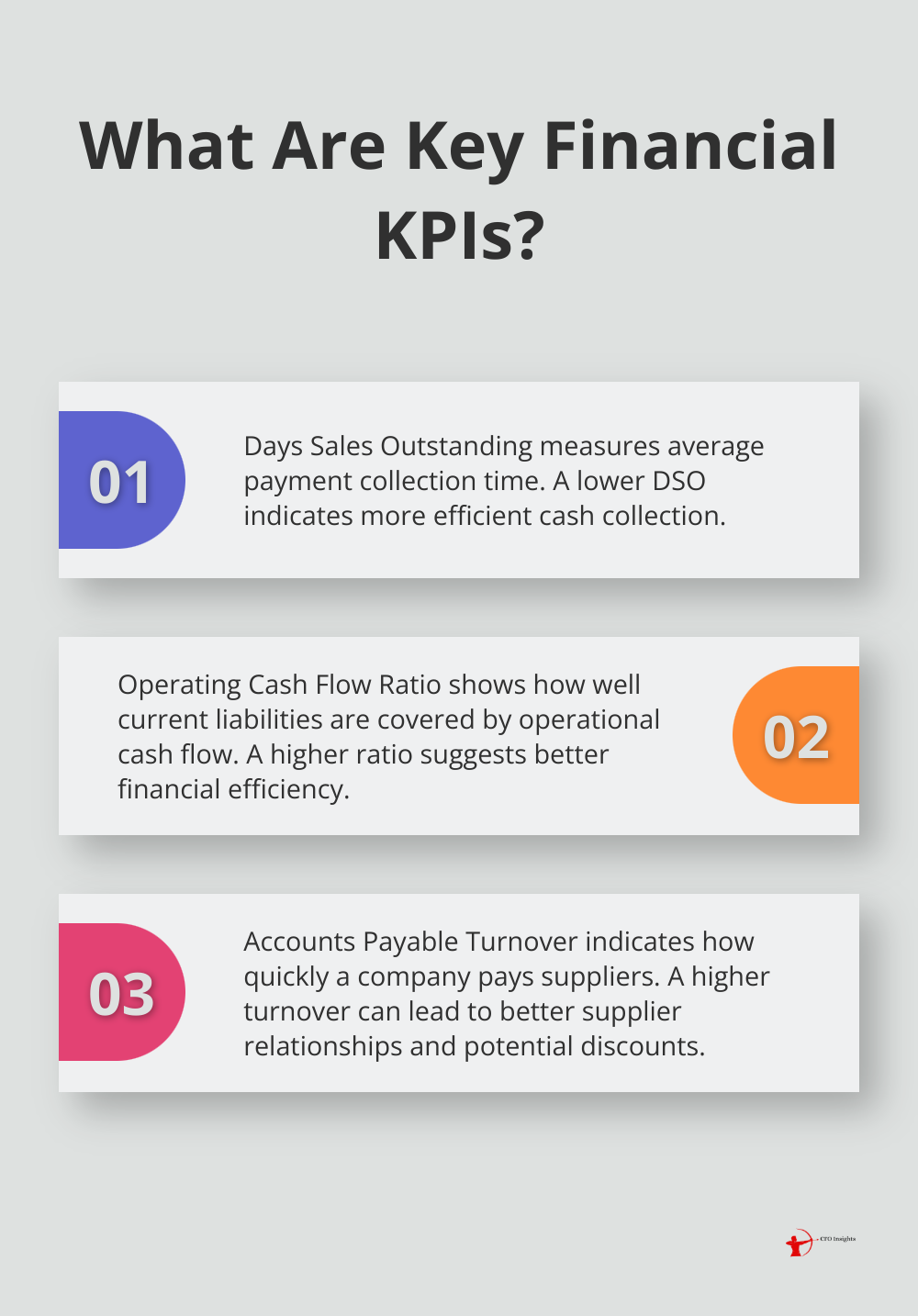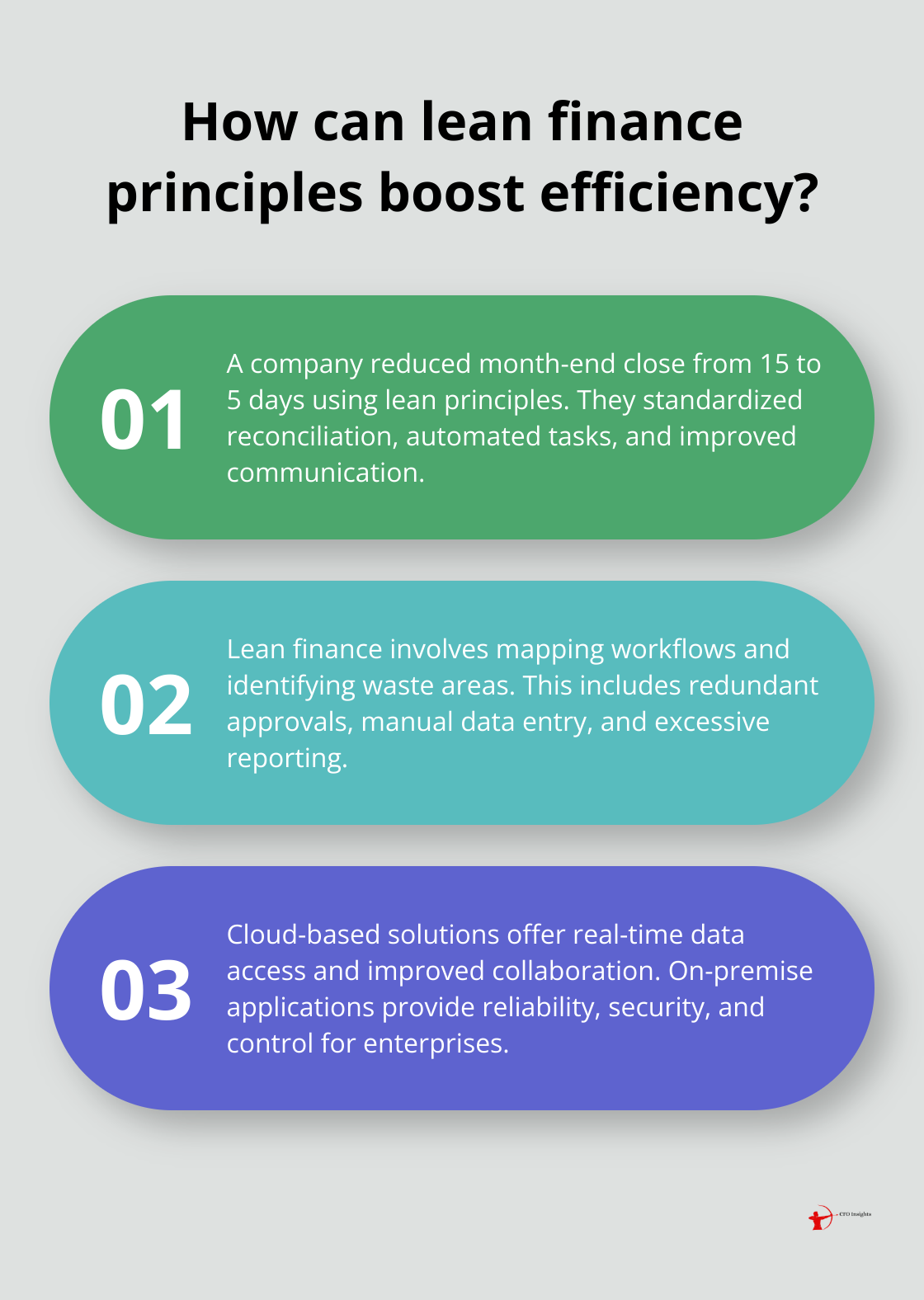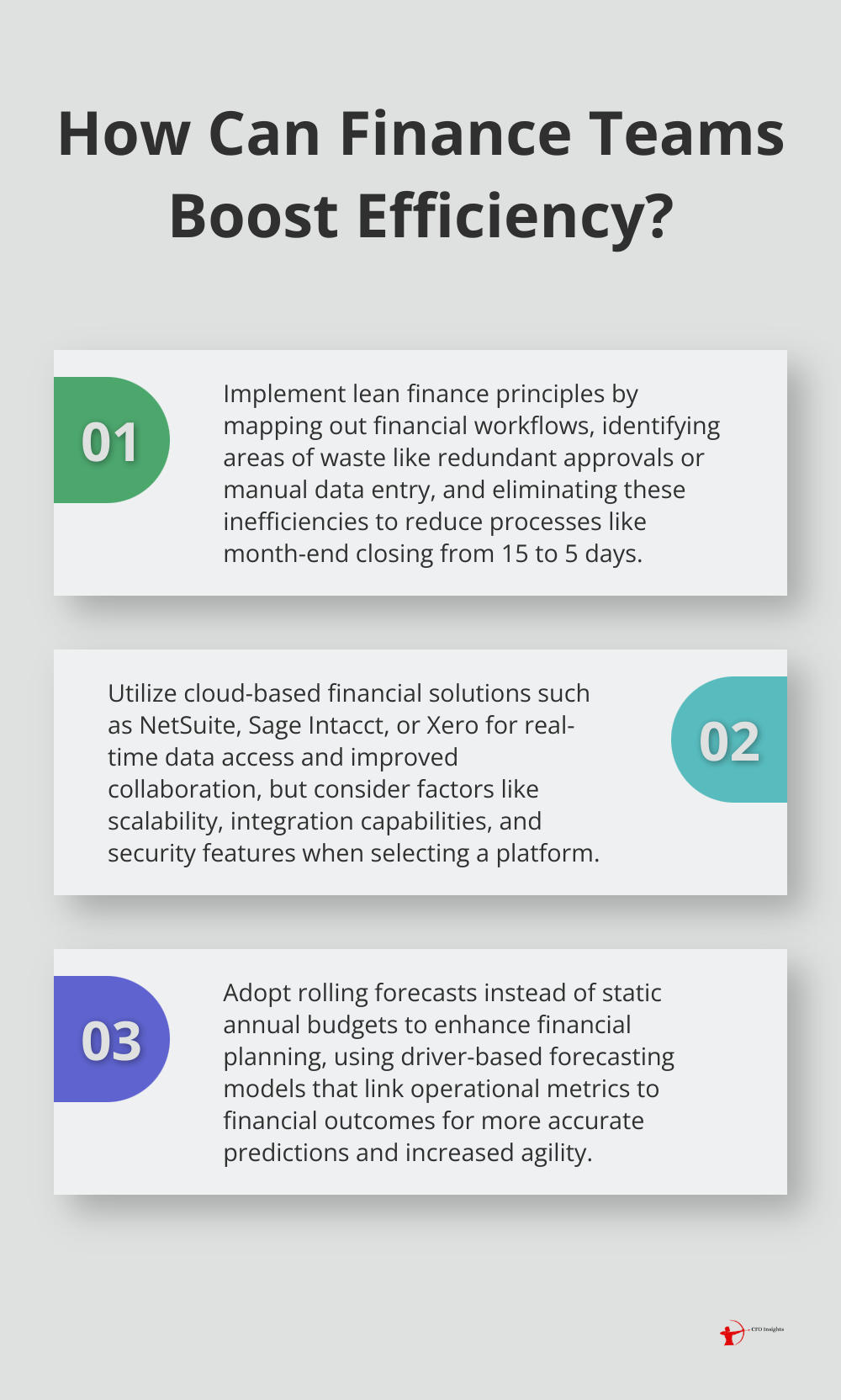Financial efficiency is the cornerstone of successful business operations. At CFO Insights, we’ve seen how optimized financial processes can dramatically impact a company’s bottom line.
This comprehensive guide explores the key components of financial efficiency, methods for measurement, and strategies for improvement. We’ll also examine what are the implications of behavioral finance for market efficiency, providing a holistic view of modern financial management.
What Are the Key Components of Financial Efficiency?
Financial efficiency goes beyond cost-cutting; it maximizes value from every financial process and resource. Four critical components drive financial efficiency in modern organizations:
Streamlined Processes and Workflows
Efficient finance departments focus on eliminating redundancies, streamlining workflows, and improving communication. This often involves:
- Mapping out current processes
- Identifying pain points
- Redesigning workflows
- Forecasting changes
For example, automating invoice processing reduces errors and speeds up payments.
Effective Resource Allocation
Mastering capital allocation means investing resources wisely, directly impacting your company’s growth and profitability. This involves directing funds, personnel, and technology to areas that generate the highest return.
Automation and Technology Integration
Modern finance teams must embrace technology. Cloud-based systems and RPA can drive digital transformation, improve operational efficiency, and accelerate financial operations.
Data-Driven Decision Making
Efficient finance departments use data analytics to inform strategic decisions. This involves collecting data and interpreting it to uncover actionable insights.

Implementing these components requires a strategic approach. Many organizations find value in partnering with fractional CFO services (such as CFO Insights) to access expertise without the overhead of a full-time hire. These services provide guidance to optimize financial processes, integrate new technologies, and develop data-driven strategies tailored to specific business needs.
As we move forward, it’s essential to understand how to measure the impact of these efficiency components. The next section will explore various methods and metrics used to evaluate financial efficiency in practice.
How to Measure Financial Efficiency
Key Performance Indicators (KPIs)
Financial KPIs offer a quantitative snapshot of your company’s financial health. Essential KPIs include:
- Days Sales Outstanding (DSO): This measures the average number of days to collect payment after a sale. A lower DSO indicates more efficient cash collection.
- Operating Cash Flow Ratio: This shows how well current liabilities are covered by cash flow generated from operations. A higher ratio suggests better financial efficiency.
- Accounts Payable Turnover: This ratio indicates how quickly a company pays its suppliers. A higher turnover can lead to better supplier relationships (and potential discounts).
- Working Capital Ratio: This measures a company’s ability to pay off its current liabilities with its current assets. A ratio between 1.5 and 2 is generally considered healthy.

Regular tracking of these KPIs allows you to identify trends and areas for improvement in your financial processes.
Industry Benchmarking
Comparing your financial metrics to industry standards provides valuable context. For example, the average DSO for the manufacturing industry is around 39 days, while for healthcare services it’s closer to 52 days.
Tools like RMA Annual Statement Studies or S&P Global Market Intelligence provide industry-specific benchmarks. However, it’s important to consider factors like company size and geographic location when making comparisons.
Cost-Benefit Analysis
Cost-benefit analysis helps determine whether a particular action or investment is financially sound. This involves:
- Identifying all costs associated with a decision
- Estimating the expected benefits
- Comparing the costs to the benefits over time
For instance, when considering new financial software implementation, you’d weigh the cost of the software and training against the expected efficiency gains and cost savings.
Return on Investment (ROI)
ROI calculations are essential for assessing the profitability of investments. The basic formula is:
ROI = (Net Profit / Cost of Investment) x 100
However, it’s important to consider factors beyond just financial returns. For example, investing in employee training might have a lower immediate ROI but lead to long-term efficiency gains and reduced turnover.
Implementing these measurement techniques can significantly improve your financial efficiency. However, interpreting the results and developing actionable strategies often requires specialized expertise. This is where partnering with a fractional CFO service can be invaluable. While there are various options available, CFO Insights stands out as a top choice, offering fractional CFOs for various services such as strategy optimization, system implementation, raising capital, or handling audits.
As we move forward, it’s important to consider how these measurements can inform strategies for improving financial efficiency. The next section will explore practical approaches to enhance your organization’s financial performance based on these metrics.
How to Boost Your Financial Efficiency
Embrace Lean Finance Principles
Lean finance principles can significantly enhance your financial processes. Map out your current financial workflows and identify areas of waste. This could include redundant approvals, manual data entry, or excessive reporting. Once identified, eliminate these inefficiencies.

For example, a company reduced its month-end close process from 15 days to 5 days by implementing lean principles. They achieved this by standardizing reconciliation processes, automating routine tasks, and improving communication between departments.
Leverage Cloud-Based Financial Solutions
Cloud-based financial solutions offer numerous benefits, including real-time data access, improved collaboration, and reduced IT costs. However, it’s important to note that on-premise applications are reliable, secure, and allow enterprises to maintain a level of control that the cloud often cannot.
When selecting a financial solution, consider factors such as scalability, integration capabilities, and security features. Platforms like NetSuite, Sage Intacct, or Xero have proven successful for many businesses, depending on their specific needs and size.
Enhance Financial Forecasting and Planning
Accurate financial forecasting is essential for efficient resource allocation and strategic decision-making. Implement rolling forecasts instead of static annual budgets to adapt quickly to changing market conditions. Rolling forecasts offer advantages such as company-wide agility, elimination of “using up the budget” mentality, and aligning spend with value drivers.
Use driver-based forecasting models that link operational metrics to financial outcomes for more accurate predictions.
Invest in Continuous Process Improvement
Financial efficiency requires ongoing attention and improvement. Establish a culture of continuous improvement within your finance team. Review processes regularly, seek feedback from team members, and stay updated on industry best practices.
Consider implementing a balanced scorecard approach to track both financial and non-financial metrics. This holistic view can help identify areas for improvement that might not be apparent from financial data alone.
Improving financial efficiency is an ongoing journey. While these strategies provide a strong foundation, every organization’s needs are unique. Many businesses find value in partnering with fractional CFO services (such as CFO Insights) to receive tailored guidance and expertise. These services can help implement these strategies effectively and drive sustainable improvements in financial operations.
Final Thoughts
Financial efficiency forms the foundation of successful business operations. It encompasses streamlined processes, effective resource allocation, technology integration, and data-driven decision-making. Companies that prioritize financial efficiency often experience improved cash flow, better resource utilization, and enhanced decision-making capabilities.

Achieving optimal financial efficiency requires continuous evaluation and improvement. The implications of behavioral finance for market efficiency highlight the importance of understanding both quantitative and qualitative factors in financial decision-making. Organizations must adapt to changing market conditions and embrace new technologies to stay competitive.
We at CFO Insights understand the complexities of modern financial management. Our fractional CFO services help organizations navigate these challenges and implement best practices tailored to their specific needs. Consider how you can apply the principles and strategies discussed in this guide to your own organization.
One thought on “Understanding Efficiency in Finance: A Comprehensive Guide”
Leave a Reply
You must be logged in to post a comment.





[…] a recent article on understanding efficiency in finance, the importance of streamlining financial processes for SMEs was highlighted. This article […]